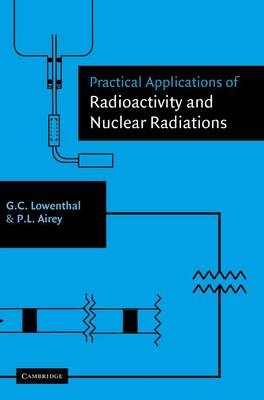
Practical Applications of Radioactivity and Nuclear Radiations
Cambridge University Press (Verlag)
978-0-521-55305-6 (ISBN)
This book is aimed at scientists and engineers wanting to use radioisotopes and the emitted ionising radiations competently but without seeking expertise. It describes decay and stability criteria, necessary precautions to ensure radiation protection and the detection of alpha, beta and gamma rays including spectrometry. There are comments on calorimetry, liquid scintillation counting, how to use secondary standard instruments, high resolution detectors and how to calculate counting results estimating uncertainties and allowing for the statistics of radionuclide decays. The book's principal purpose is to encourage radionuclide applications which can be done safely, reliably and accurately. It describes industrial and scientific applications of alpha, beta, and gamma rays, neutrons and high energy radiations. This book will be of particular interest to scientists and technologists, teachers and students, helping them to work with radioisotopes safely, efficiently and reliably.
Dr Lowenthal was the leader of a small Group at the AAEC which established the Australian Standards of Radioactivity. He was invited in the mid-1970s to represent Australia on the Consultative Committee for Standards for the Measurement of Ionising Radiations of the International Committee for Weights and Measures, Paris. He has published some 15 research papers with other members of his Group in refereed scientific journals. He was for six years honorary Australasian Editor of the International Journal of Applied Radiation and Isotopes. He is currently an honorary consultant for Nuclear Medicine and is also a Visiting Fellow within the School of Mechanical Engineering at the University of New South Wales. For his contributions to radionuclide metrology he was named Chevalier de l'Ordre National du Mérite by the President of France in 1994 and was named by the Governor-General, a Member of the General Division of the Order of Australia in 1999. Dr Airey is a physical chemist, who has been extensively involved in research into the applications of radioactivity and radiation to industry and the environment. He was appointed to the International Atomic Energy Agency, Vienna, Austria where he coordinated a range of programs involving these applications in Asia and the Pacific. He is the Australian National Counterpart for the IAEA radiotracer program. He is also responsible for coordinating an international OECD/NEA project concerned with the evaluation of uranium deposits as natural analogues of radioactive waste repositories. From 1992 to 1999 he was ANSTO's representative on the independent Safety Review Committee. Dr Airey is a past president of the Australian Nuclear Association and has published over sixty research papers and technical reports.
1. Atoms, nuclides and radionuclides; 2. Units and standards for radioactivity and radiation dosimetry and rules for radiation protection; 3. Properties of radiations emitted from radionuclides; 4. Nuclear radiations from a user's perspective; 5. Ionising radiation detectors; 6. Radioactivity and countrate measurements and the presentation of results; 7. Industrial applications of radioisotopes and radiation; 8. Application of tracer technology to industry and the environment; 9. Radionuclides to protect the environment.
| Zusatzinfo | 40 Tables, unspecified; 120 Line drawings, unspecified |
|---|---|
| Verlagsort | Cambridge |
| Sprache | englisch |
| Maße | 170 x 244 mm |
| Gewicht | 780 g |
| Themenwelt | Naturwissenschaften ► Physik / Astronomie ► Atom- / Kern- / Molekularphysik |
| ISBN-10 | 0-521-55305-9 / 0521553059 |
| ISBN-13 | 978-0-521-55305-6 / 9780521553056 |
| Zustand | Neuware |
| Haben Sie eine Frage zum Produkt? |
aus dem Bereich


